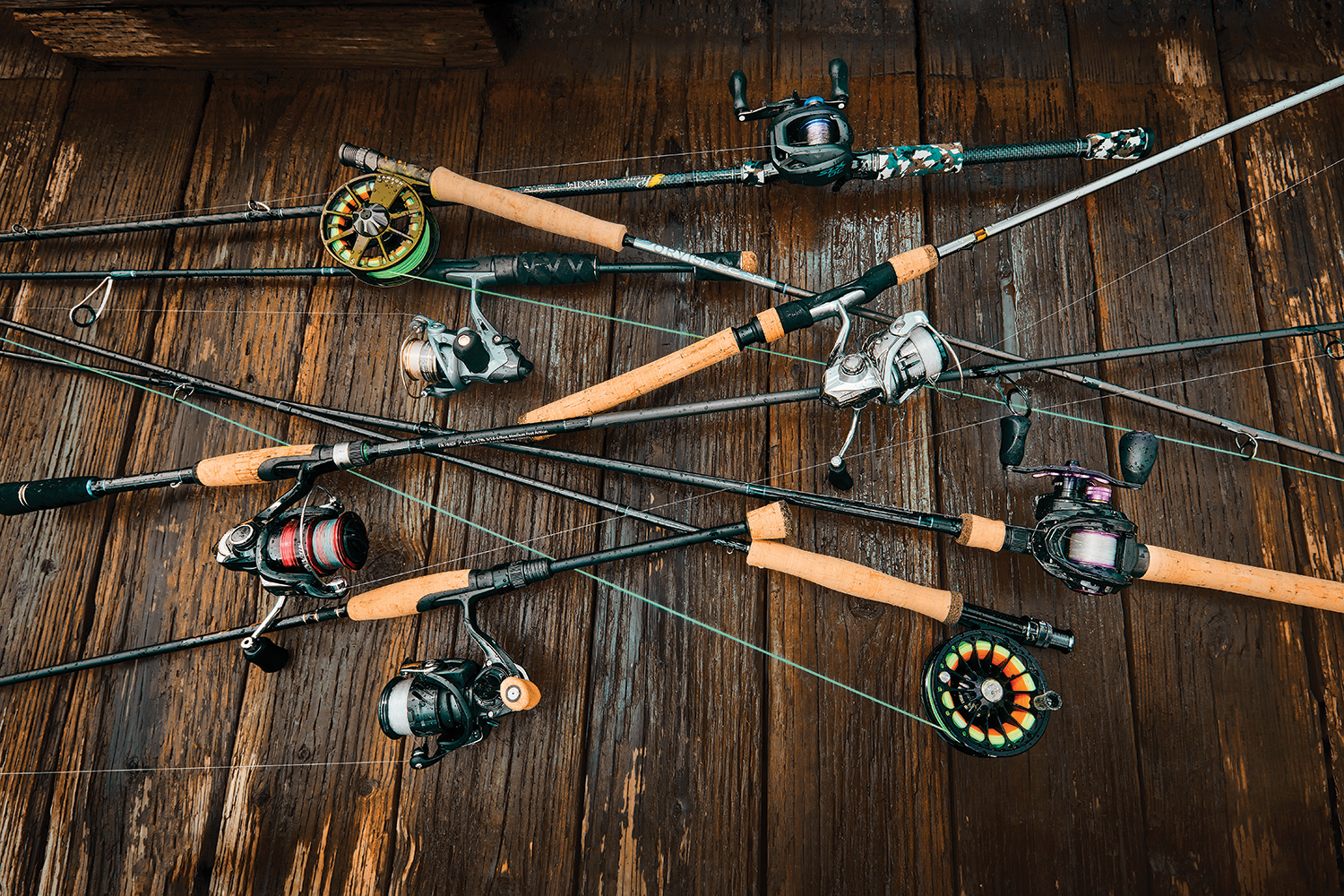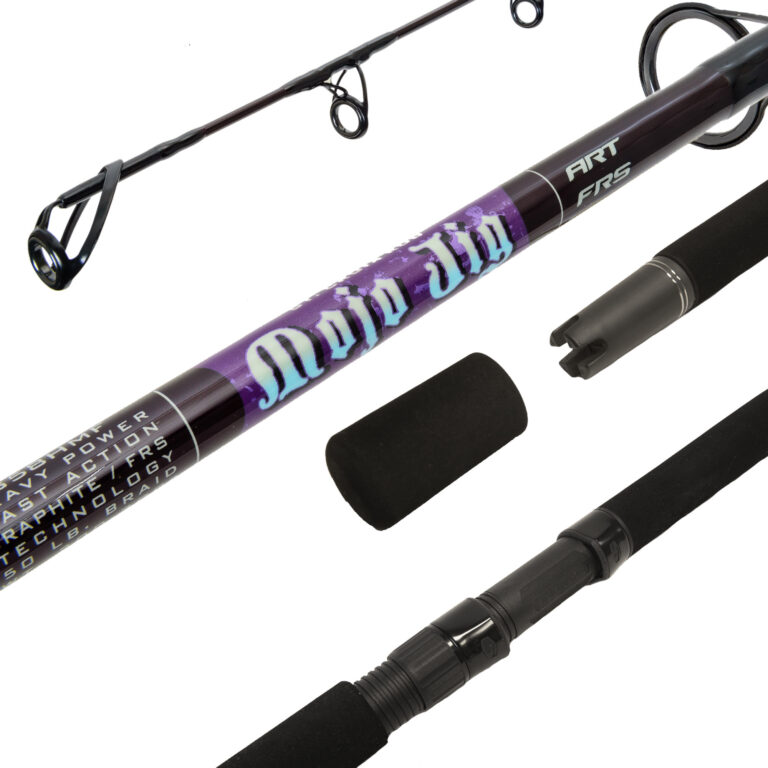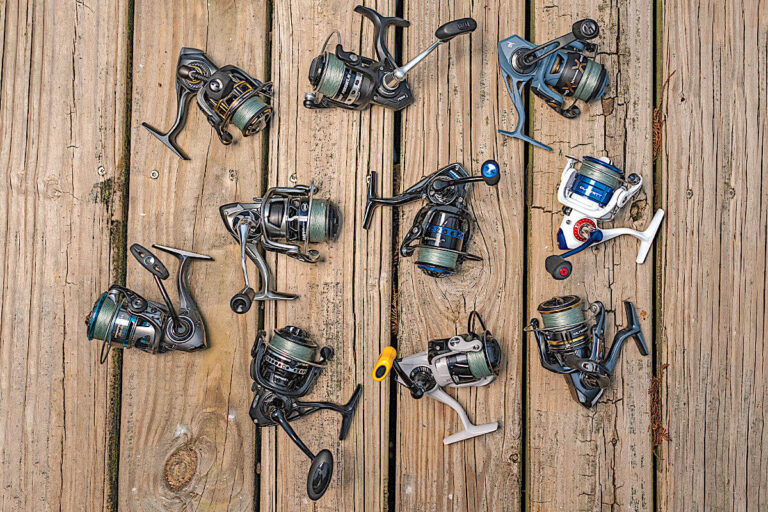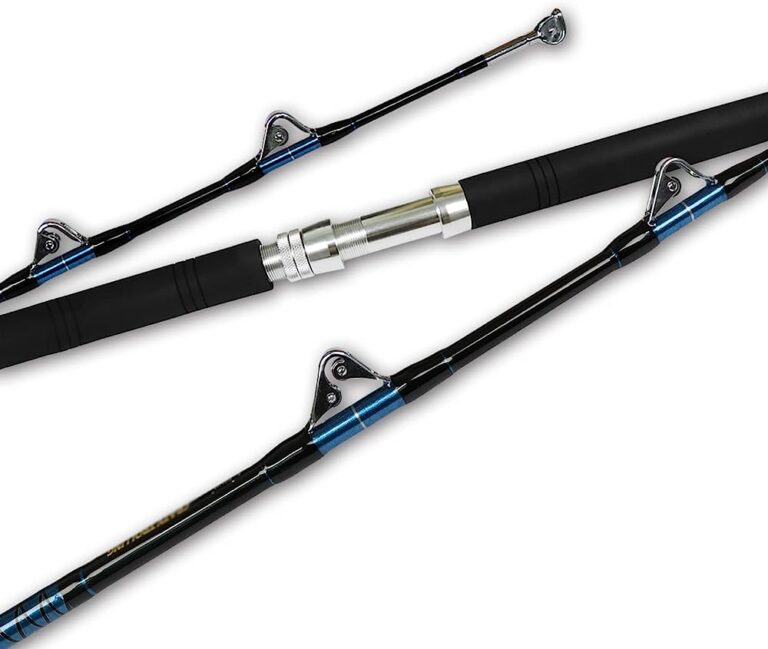Choose the right number of rod guides for a spinning rod based on the length and power of the rod, as well as the type of fishing you plan to do. When determining the appropriate number of rod guides, consider that more guides generally provide better rod action and casting distance, while fewer guides reduce weight and allow for easier line control.
The key is to strike a balance that suits your rod’s characteristics and your fishing style. By finding the right number of rod guides, you can optimize your spinning rod’s performance and enhance your overall fishing experience.

Credit: www.outdoorlife.com
Understand The Importance Of Rod Guides For A Spinning Rod
The Role Of Rod Guides In Enhancing Fishing Performance
Rod guides play a crucial role in enhancing the overall performance of a spinning rod. They may seem like small, inconspicuous components, but they have significant impacts on various aspects of your fishing experience. Understanding the importance of rod guides can help you make informed decisions when choosing the right number for your spinning rod.
Here are the key points to consider:
- Casting distance: Rod guides are designed to maximize casting distance. They guide the fishing line along the length of the rod, allowing for smoother and more efficient line flow. The proper number and placement of rod guides can reduce line friction and resistance, allowing you to achieve greater casting distances.
- Line control: With the right rod guides, you can have better control over your fishing line. The guides help distribute the line evenly along the length of the rod, preventing tangles and snags. This ensures smooth line flow during casting and retrieval, enhancing your ability to control and manipulate the line as needed.
- Sensitivity: Rod guides impact the sensitivity of your spinning rod. The line passes through each guide, and the vibrations from bites or movements of the fish are transmitted to the rod tip. The number and quality of rod guides directly affect how well you can detect these subtle vibrations. Optimal sensitivity allows you to feel even the slightest nibbles, resulting in improved hook sets and successful catches.
How Rod Guides Impact Casting Distance, Line Control, And Sensitivity
To further understand the impact of rod guides on casting distance, line control, and sensitivity, let’s delve into the specifics:
- Casting distance: Properly spaced rod guides with the right number can reduce line friction and promote smooth line flow during casting. Each guide reduces the strain on the line, enabling it to flow more freely and achieve greater distances. The uniform dispersion of guides along the rod blank ensures an even distribution of line tension, preventing any loss of distance due to uneven pressure.
- Line control: Well-positioned rod guides keep the fishing line in close proximity to the rod blank, minimizing its chances of tangling or getting snagged. This enhanced line control enables you to make accurate casts with greater precision and avoid frustration caused by line mishaps. Additionally, the guides help in guiding the line back onto the reel during retrieval, maintaining control throughout the entire fishing process.
- Sensitivity: The number and quality of rod guides directly affect the sensitivity of your spinning rod. More guides create more contact points for the line against the rod blank, allowing for enhanced sensitivity. This heightened sensitivity enables you to detect even the slightest movements or bites, resulting in timely hook sets and increased catch rates. Additionally, high-quality guides made from materials like ceramic or stainless steel provide better sensitivity by efficiently transmitting vibrations to the rod tip.
The Significance Of Choosing The Right Rod Guides For Different Fishing Techniques
Different fishing techniques require varying rod guide configurations. Consider the following when choosing the right rod guides for your specific fishing style:
- Baitcasting: Baitcasting rods often have fewer rod guides compared to spinning rods. This configuration provides a smoother flow of heavier lines and allows for better control and accuracy during baitcasting.
- Spinning: Spinning rods generally require a higher number of rod guides, especially when using lighter lines. This ensures proper line control, reduces line twists, and enhances casting distance. The smaller guides towards the tip of the rod optimize sensitivity, crucial for finesse techniques such as drop shotting or fishing with light lures.
- Surf fishing: Rods used for surf fishing require a robust guide system to handle the heavier lines and weights used for long-distance casting. The guides should be larger to accommodate the thicker lines and prevent them from tangling, providing smooth casts in challenging surf conditions.
- Fly fishing: Fly rods have their unique guide system called snake guides. These guides are designed to guide the fly line smoothly along the length of the rod during casting and retrieval. Properly spaced snake guides ensure optimal line control and casting performance for fly fishing techniques.
Remember, choosing the right number of rod guides for your spinning rod is essential for maximizing your fishing experience. Carefully consider the specific needs of your fishing techniques and select the appropriate guide configuration to enhance casting distance, line control, and sensitivity.
Factors To Consider When Choosing Rod Guides
Choosing the right number of rod guides for a spinning rod is crucial for optimal performance and casting accuracy. Your rod guides play a significant role in controlling line flow, reducing friction, and protecting your fishing line. There are several factors you should consider when selecting rod guides, including the material, frame design, guide size and quantity, and guide placement.
Let’s dive deeper into each of these factors.
Material: Exploring The Pros And Cons Of Various Rod Guide Materials
When it comes to selecting the material for your rod guides, there are several options available, each with its own advantages and disadvantages. Here are some key points to consider:
- Stainless steel: Stainless steel guides are the most common and widely used. They are durable, corrosion-resistant, and relatively affordable. However, they may be heavier compared to other materials, which could affect the sensitivity and overall weight of your rod.
- Titanium: Titanium guides are lighter than stainless steel and offer excellent strength and corrosion resistance. They provide increased sensitivity, which can enhance your fishing experience. However, titanium guides can be more expensive than other options.
- Ceramic: Ceramic guides are known for their smooth surface, which minimizes friction and allows for longer and smoother casts. They are lightweight and highly heat-resistant. However, ceramic guides can be prone to breakage if not handled carefully.
Frame Design: Understanding The Impact Of Different Frame Designs On Rod Performance And Durability
The frame design of your rod guides can greatly impact the overall performance and durability of your spinning rod. Here are a few points to keep in mind:
- Single-foot guides: Single-foot guides have only one foot connecting the frame to the rod. They are lightweight and flexible, providing greater sensitivity and responsiveness. However, they may be less durable compared to other frame designs.
- Double-foot guides: Double-foot guides have two feet, making them more stable and sturdy. They distribute stress more evenly across the rod, increasing its durability. However, they may add extra weight and affect the sensitivity of your rod.
- Low-profile guides: Low-profile guides are designed to sit closer to the rod blank, reducing line slap and improving casting accuracy. They are commonly used in modern spinning rods for better line control and overall performance.
Guide Size And Quantity: Determining The Optimal Number And Size Of Guides Based On Rod Length And Power
The number and size of rod guides play a crucial role in determining the performance and casting efficiency of your spinning rod. Consider the following points:
- Rod length: Longer rods generally require more guides, spaced closer together, to distribute stress and allow for a smoother line flow during casting and retrieval.
- Rod power: The power or stiffness of your rod influences the number of guides you should use. A powerful rod requires more guides to provide better line control and prevent rod blank distortion during heavy loads.
- Guide size: The guide size should be chosen based on the type of fishing line you’re using. Larger guides are suitable for thicker lines, while smaller guides work best for lighter lines. It’s important to strike a balance between line flow and reduced friction.
Guide Placement: Exploring The Benefits Of Different Guide Placement Techniques And Their Influence On Rod Action
Guide placement is a crucial factor that directly affects the rod’s action, sensitivity, and overall performance. Consider the following techniques:
- Spacing: The spacing between guides should be consistent and calculated based on the rod’s length and power. Proper spacing helps distribute stress evenly and promotes smooth line flow.
- Reduction train: The reduction train technique involves gradually reducing the size of the guides from the butt to the tip of the rod. This ensures better line control and casting accuracy.
- Concept guide systems: Advanced guide systems, such as the new guide concept (ngc), are designed to optimize casting performance and reduce line slap. These systems utilize a combination of different guide sizes and placements.
By taking into consideration the material, frame design, guide size and quantity, and guide placement, you can choose the right number of rod guides for your spinning rod. Remember that the specific requirements may vary depending on your fishing style, target species, and personal preferences.
Experimentation can also help you fine-tune the performance of your rod guides for the best fishing experience.
Choosing The Right Rod Guide Type For Specific Fishing Techniques
When it comes to selecting the appropriate rod guides for your spinning rod setup, there are a few key considerations to keep in mind. Different fishing techniques require specific types of rod guides to enhance performance and ensure a smooth fishing experience.
Let’s dive into the different types of rod guides and how to choose the right one for your fishing style:
Spinning Guides: How To Select The Appropriate Spinning Guides For A Spinning Rod Setup
- Ensure that the spinning guides are lightweight: Lightweight guides allow for improved sensitivity and better control over your fishing line.
- Opt for ceramic or titanium guide inserts: These materials reduce friction and provide smoother line flow, resulting in increased casting distance and accuracy.
- Look for guides with a large inner diameter: This feature minimizes line friction and allows for longer casts.
- Consider the number of guides: Generally, more guides evenly distribute the load on the rod, enhancing its strength and responsiveness. Aim for 5-10 guides, depending on the length of your spinning rod.
Casting Guides: Understanding The Key Considerations When Choosing Casting Guides For A Spinning Rod
- Select guides compatible with casting reels: Casting guides are designed to accommodate the larger diameter of casting reels and prevent line tangling during casting.
- Opt for guides with durable frames: Casting rods exert more pressure on the guides, so it’s crucial to choose ones with sturdy frames to withstand the stress.
- Consider the type of line you use: Different guides are suitable for various line types, such as monofilament, fluorocarbon, or braided lines. Ensure compatibility to avoid damage to your line.
- Look for guides with a low-profile design: Low-profile guides help to reduce line slap against the rod, resulting in increased casting distance and accuracy.
Surf Guides: Tips For Selecting Surf Guides That Are Suitable For Long-Distance Casting
- Choose large-sized guides: Surf fishing often involves long casts, so selecting guides with a larger diameter can facilitate smoother line flow and longer casting distance.
- Opt for corrosion-resistant materials: Saltwater can be harsh on equipment, so it’s crucial to choose surf guides made from materials like stainless steel or titanium that can withstand corrosive environments.
- Consider the guide’s height: Surf rods require taller guides to prevent line slap against the rod and reduce friction, resulting in longer casting distances.
- Look for guides with a sturdy frame: Surf fishing involves handling larger fish and dealing with the strong resistance of waves. Sturdy guide frames can handle the added pressure and provide better overall performance.
Fly Rod Guides: Exploring The Unique Characteristics Of Rod Guides Designed For Fly Fishing Rods
- Select guides with a large diameter: Fly lines are thicker and more delicate than traditional fishing lines. Choosing guides with a larger diameter ensures smooth line movement and reduces the chance of tangling or line friction.
- Opt for snake guides: Snake guides are the most common type used in fly fishing rods. Their lightweight design allows for enhanced sensitivity and delicacy, crucial for the precise and subtle presentations required in fly fishing.
- Consider guide spacing: Proper spacing between guides is crucial for the fly line to cast smoothly. It’s important to follow the manufacturer’s recommendations on guide placement to optimize the performance of your fly fishing rod.
- Look for guides with a corrosion-resistant finish: Fly fishing often takes place in freshwater environments where corrosion may not be as prominent, but it’s still important to choose guides with a protective finish that can handle occasional exposure to saltwater.
Remember, the right rod guide type can greatly impact your fishing experience, so take the time to evaluate your fishing technique and choose guides that align with your needs. Happy fishing!
Conclusion
Selecting the appropriate number of rod guides for your spinning rod is crucial for optimizing performance and achieving a more enjoyable fishing experience. By considering factors such as rod length, line weight, and fishing technique, you can determine the ideal number of rod guides to enhance casting, reduce line tangling, and increase sensitivity.
Each guide plays a significant role in ensuring smooth line flow, reducing friction, and distributing stress evenly along the rod. Remember to choose high-quality guides made from durable materials to prevent guide failure and damage. Properly spaced guides will also help maintain the rod’s flexibility and prevent it from becoming too stiff.
Taking the time to select the right number of rod guides will ultimately enhance your fishing efficiency and success, allowing you to fully enjoy your time on the water.




